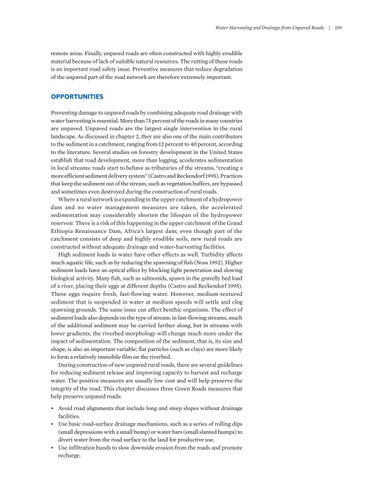Water Harvesting and Drainage from Unpaved Roads | 159
remote areas. Finally, unpaved roads are often constructed with highly erodible material because of lack of suitable natural resources. The rutting of these roads is an important road safety issue. Preventive measures that reduce degradation of the unpaved part of the road network are therefore extremely important.
OPPORTUNITIES Preventing damage to unpaved roads by combining adequate road drainage with water harvesting is essential. More than 75 percent of the roads in many countries are unpaved. Unpaved roads are the largest single intervention in the rural landscape. As discussed in chapter 2, they are also one of the main contributors to the sediment in a catchment, ranging from 12 percent to 40 percent, according to the literature. Several studies on forestry development in the United States establish that road development, more than logging, accelerates sedimentation in local streams: roads start to behave as tributaries of the streams, “creating a more efficient sediment delivery system” (Castro and Reckendorf 1995). Practices that keep the sediment out of the stream, such as vegetation buffers, are bypassed and sometimes even destroyed during the construction of rural roads. Where a rural network is expanding in the upper catchment of a hydropower dam and no water management measures are taken, the accelerated sedimentation may considerably shorten the lifespan of the hydropower reservoir. There is a risk of this happening in the upper catchment of the Grand Ethiopia Renaissance Dam, Africa’s largest dam; even though part of the catchment consists of deep and highly erodible soils, new rural roads are constructed without adequate drainage and water-harvesting facilities. High sediment loads in water have other effects as well. Turbidity affects much aquatic life, such as by reducing the spawning of fish (Noss 1992). Higher sediment loads have an optical effect by blocking light penetration and slowing biological activity. Many fish, such as salmonids, spawn in the gravelly bed load of a river, placing their eggs at different depths (Castro and Reckendorf 1995). These eggs require fresh, fast-flowing water. However, medium-textured sediment that is suspended in water at medium speeds will settle and clog spawning grounds. The same issue can affect benthic organisms. The effect of sediment loads also depends on the type of stream: in fast-flowing streams, much of the additional sediment may be carried farther along, but in streams with lower gradients, the riverbed morphology will change much more under the impact of sedimentation. The composition of the sediment, that is, its size and shape, is also an important variable; flat particles (such as clays) are more likely to form a relatively immobile film on the riverbed. During construction of new unpaved rural roads, there are several guidelines for reducing sediment release and improving capacity to harvest and recharge water. The positive measures are usually low cost and will help preserve the integrity of the road. This chapter discusses three Green Roads measures that help preserve unpaved roads: • Avoid road alignments that include long and steep slopes without drainage facilities. • Use basic road-surface drainage mechanisms, such as a series of rolling dips (small depressions with a small bump) or water bars (small slanted humps) to divert water from the road surface to the land for productive use. • Use infiltration bunds to slow downside erosion from the roads and promote recharge.







































